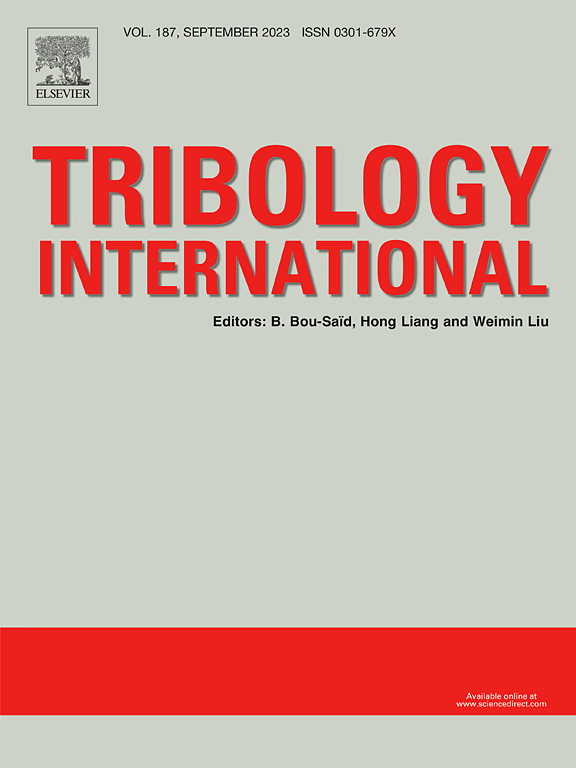Using lubricant composition to control friction-induced-vibration in an elastomer-steel contact representing a hydraulic seal
IF 6.1
1区 工程技术
Q1 ENGINEERING, MECHANICAL
引用次数: 0
Abstract
Hydraulic seals are key industrial components that can suffer from unwanted friction induced vibration (FIV). The types of FIV mechanism that occur in these components, and how they may be controlled, are not well known. We conducted sliding friction tests on contacts between seal materials, lubricated by hydraulic fluids, under speeds and contact pressures typical of hydraulic machines. FIV that occurred under certain conditions was captured and analysed. Results suggest 1) two FIV mechanisms are occurring: classic stick-slip and speed dependant friction instability, the 2) occurrence and severity of these mechanisms are correlated with the ratio of static to dynamic friction and the gradient of the friction vs. speed (Stribeck) curve, respectively, 3) these parameters can be controlled by including an appropriate additive package in the lubricant and this significantly reduces FIV, 4) most FIV occurs at low temperature and high load since these both lead to low kinetic friction (due to thicker hydrodynamic films and smoother surfaces) and thus promote stick-slip. This may explain instances of noise known in practice as the “Monday-morning effect” and suggests how this too may be alleviated through lubricant formulation.
使用润滑剂成分控制代表液压密封件的弹性体-钢接触中的摩擦引起的振动
液压密封件是关键的工业部件,可能会受到不必要的摩擦诱导振动(FIV)的影响。人们对发生在这些元件中的 FIV 机制类型以及如何控制这些机制还不甚了解。我们在液压机的典型速度和接触压力下,对使用液压油润滑的密封材料之间的接触进行了滑动摩擦试验。我们捕捉并分析了在特定条件下发生的 FIV。结果表明:1)发生了两种 FIV 机制:典型的粘滑和速度相关摩擦不稳定性;2)这些机制的发生和严重程度与静摩擦力与动摩擦力的比率以及摩擦力与速度(Stribeck)曲线的梯度相关。3)这些参数可通过在润滑油中加入适当的复合添加剂来控制,从而显著降低摩擦不稳定性,4)大多数摩擦不稳定性发生在低温和高负荷下,因为这两种情况都会导致低动摩擦力(由于流体动力膜更厚和表面更光滑),从而促进粘滑。这可以解释在实践中被称为 "周一早晨效应 "的噪音现象,并说明如何通过润滑油配方来减轻这种现象。
本文章由计算机程序翻译,如有差异,请以英文原文为准。
求助全文
约1分钟内获得全文
求助全文
来源期刊

Tribology International
工程技术-工程:机械
CiteScore
10.10
自引率
16.10%
发文量
627
审稿时长
35 days
期刊介绍:
Tribology is the science of rubbing surfaces and contributes to every facet of our everyday life, from live cell friction to engine lubrication and seismology. As such tribology is truly multidisciplinary and this extraordinary breadth of scientific interest is reflected in the scope of Tribology International.
Tribology International seeks to publish original research papers of the highest scientific quality to provide an archival resource for scientists from all backgrounds. Written contributions are invited reporting experimental and modelling studies both in established areas of tribology and emerging fields. Scientific topics include the physics or chemistry of tribo-surfaces, bio-tribology, surface engineering and materials, contact mechanics, nano-tribology, lubricants and hydrodynamic lubrication.
 求助内容:
求助内容: 应助结果提醒方式:
应助结果提醒方式:


